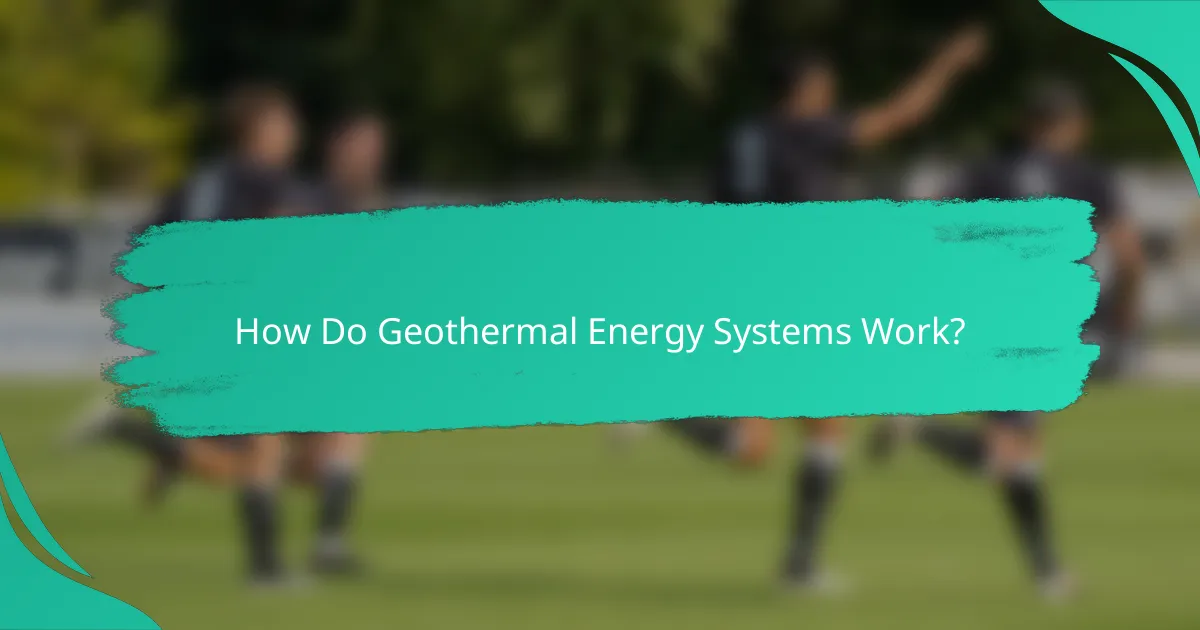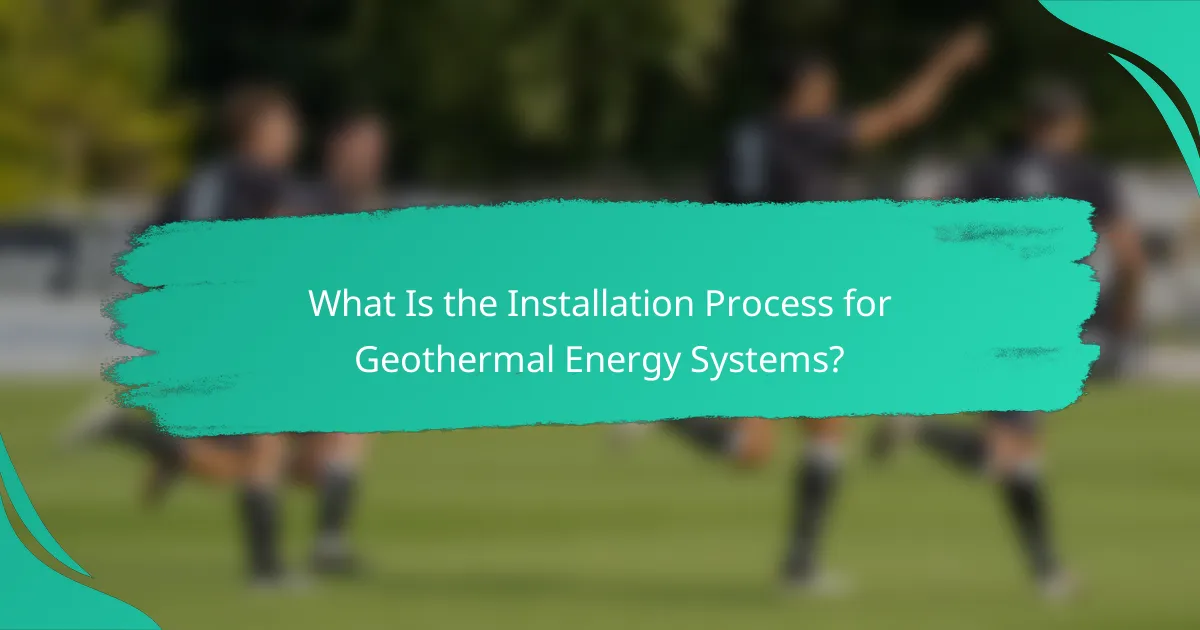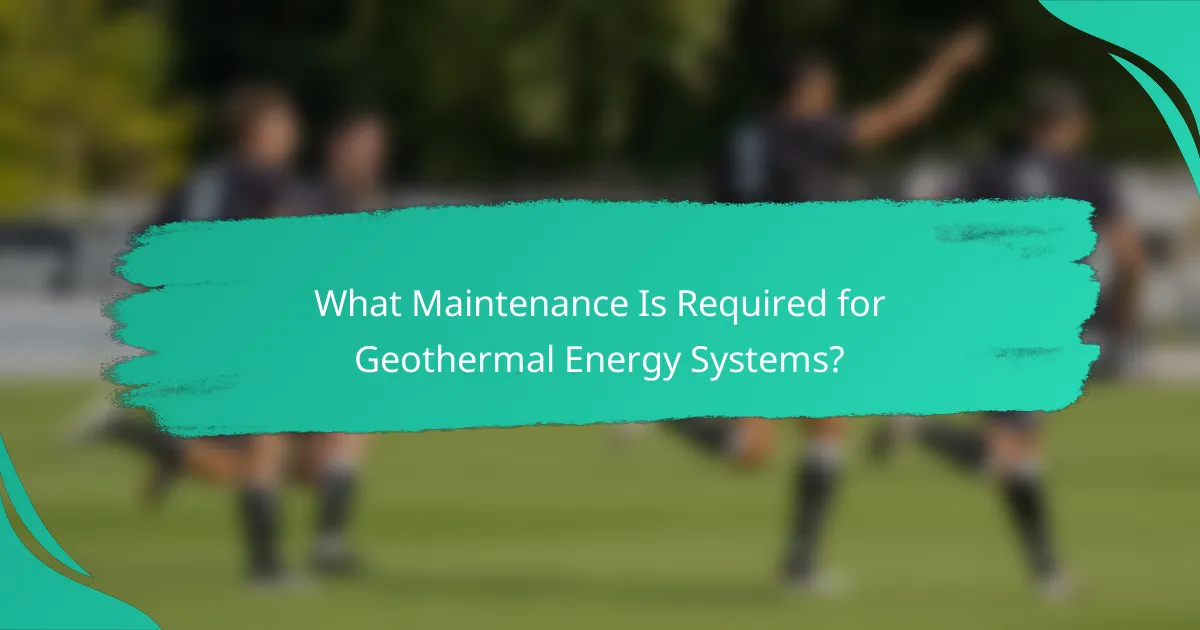Geothermal energy systems utilize the Earth’s natural heat to deliver efficient heating, cooling, and electricity, making them a sustainable energy solution. By tapping into the stable underground temperatures, these systems not only reduce energy costs but also offer significant environmental benefits. Proper installation and maintenance are crucial for maximizing their efficiency and effectiveness, involving careful site assessment and integration processes.

What Are the Benefits of Geothermal Energy Systems?
Geothermal energy systems offer numerous advantages, including cost savings, environmental benefits, and enhanced energy efficiency. These systems harness the Earth’s natural heat, providing a reliable and sustainable energy source for heating and cooling applications.
Low operating costs
Geothermal energy systems typically have low operating costs due to their efficient use of the Earth’s heat. Once installed, these systems require minimal energy to operate, often resulting in significantly lower utility bills compared to traditional heating and cooling methods.
For instance, homeowners can expect to save anywhere from 30% to 60% on their energy costs. This long-term savings can offset the initial installation expenses over time, making geothermal systems a financially sound investment.
Environmental sustainability
Geothermal energy is a clean and renewable resource, contributing to environmental sustainability. By utilizing the Earth’s heat, these systems produce very low greenhouse gas emissions compared to fossil fuel-based systems.
Moreover, geothermal systems have a minimal land footprint and do not require large amounts of water for operation, making them an eco-friendly choice for energy generation. This aligns with global efforts to reduce carbon footprints and combat climate change.
Energy efficiency
Geothermal systems are known for their high energy efficiency, often achieving efficiency ratings of 300% to 600%. This means they can produce three to six units of energy for every unit consumed, making them one of the most efficient heating and cooling options available.
In addition, these systems can provide consistent temperatures year-round, reducing the need for additional heating or cooling sources. This efficiency translates into lower energy consumption and reduced environmental impact.
Long lifespan
Geothermal energy systems are designed for longevity, with many components lasting 20 years or more. The ground loops, which are essential for heat exchange, can last over 50 years with proper installation and maintenance.
This durability means that homeowners can enjoy reliable performance and savings over a long period, making geothermal systems a worthwhile investment in the long run.
Energy independence
By utilizing geothermal energy, homeowners can achieve greater energy independence. This system reduces reliance on fossil fuels and fluctuating energy markets, providing a stable and predictable energy source.
As more households adopt geothermal systems, the collective demand for traditional energy sources decreases, contributing to a more resilient and sustainable energy future. This shift can help stabilize energy prices and enhance energy security for communities.

How Do Geothermal Energy Systems Work?
Geothermal energy systems harness heat from the Earth’s interior to provide heating, cooling, and electricity. They operate by transferring heat to or from the ground, utilizing the relatively stable temperatures found underground.
Heat exchange process
The heat exchange process in geothermal systems involves circulating a fluid, typically water or a refrigerant, through underground pipes. As this fluid travels through the ground, it absorbs heat during colder months or releases heat during warmer months. This exchange allows for efficient temperature regulation in buildings.
In closed-loop systems, the fluid circulates continuously in a sealed loop, while open-loop systems draw water from a well or surface body, using it for heat exchange before returning it to the source. Each method has its advantages, such as efficiency and environmental impact.
Types of geothermal systems
There are primarily three types of geothermal systems: ground-source heat pumps, direct-use systems, and geothermal power plants. Ground-source heat pumps are the most common for residential use, providing efficient heating and cooling by utilizing the earth’s stable temperatures.
Direct-use systems utilize hot water from geothermal reservoirs for heating applications, such as district heating or greenhouse heating. Geothermal power plants convert geothermal energy into electricity, typically found in areas with high geothermal activity, like Iceland or parts of the United States.
Energy conversion methods
Energy conversion methods in geothermal systems include binary cycle, flash steam, and dry steam technologies. Binary cycle plants transfer heat from geothermal water to a secondary fluid with a lower boiling point, which vaporizes and drives a turbine to generate electricity.
Flash steam plants allow high-pressure geothermal water to expand and vaporize when it reaches the surface, driving a turbine. Dry steam plants directly use steam from geothermal reservoirs to turn turbines. Each method has its efficiency levels and suitability depending on the geothermal resource available.

What Is the Installation Process for Geothermal Energy Systems?
The installation process for geothermal energy systems involves several key steps that ensure the system is efficient and effective. This process typically includes site assessment, system design, drilling and excavation, and system integration.
Site assessment
The site assessment is crucial for determining the feasibility of a geothermal energy system. This involves evaluating the geological conditions, soil type, and groundwater availability to ensure optimal heat exchange. A professional assessment can help identify the best locations for drilling and the type of system that will work best.
During this phase, factors such as land size, zoning regulations, and proximity to existing infrastructure are also considered. Engaging with local authorities may be necessary to comply with any regulations or permits required for installation.
System design
System design focuses on creating a tailored geothermal solution based on the site assessment findings. This includes selecting the appropriate type of geothermal system, such as closed-loop or open-loop, and determining the size and capacity needed to meet energy demands. Calculations for heat load and energy efficiency are essential during this stage.
Collaboration with engineers and contractors is vital to ensure that the design meets both performance expectations and budget constraints. A well-thought-out design can significantly impact the system’s long-term efficiency and operational costs.
Drilling and excavation
Drilling and excavation are physical steps in the installation process where boreholes are created for the geothermal loops. The depth and number of boreholes depend on the system design and the thermal properties of the site. Typically, boreholes can range from 100 to 400 feet deep.
It is important to choose experienced contractors for this step to minimize risks and ensure compliance with local regulations. Proper planning can help avoid potential issues such as groundwater contamination or disruption to the surrounding environment.
System integration
System integration involves connecting the geothermal loops to the building’s heating and cooling systems. This step requires careful coordination to ensure that all components work seamlessly together. It may involve installing heat pumps, ductwork, and control systems to optimize performance.
Testing the system after installation is essential to verify that it operates efficiently and meets the expected energy output. Regular maintenance checks should also be scheduled to ensure long-term reliability and efficiency of the geothermal energy system.

What Are the Costs Involved in Installing Geothermal Energy Systems?
Installing geothermal energy systems involves several costs, including initial investments, long-term savings, and potential incentives. Understanding these financial aspects is crucial for evaluating the feasibility and benefits of such systems.
Initial investment
The initial investment for geothermal energy systems can vary significantly based on the system type and installation complexity. Homeowners can expect to pay anywhere from $10,000 to $30,000 for a residential system, depending on factors like property size and ground conditions.
Costs include drilling or excavation, equipment purchase, and installation labor. It’s essential to obtain multiple quotes from qualified contractors to ensure competitive pricing and quality service.
Long-term savings
Geothermal systems typically offer substantial long-term savings on energy bills. Homeowners can save between 30% to 60% on heating and cooling costs compared to traditional systems, leading to a return on investment within 5 to 10 years.
Additionally, geothermal systems have a long lifespan, often exceeding 20 years for the ground loop and 15 years for the heat pump, which further enhances their cost-effectiveness over time.
Incentives and rebates
Many regions offer incentives and rebates to encourage the adoption of geothermal energy systems. These can significantly reduce the upfront costs, with some programs providing rebates of up to 30% of the installation costs.
Homeowners should check local and federal programs, such as the Federal Investment Tax Credit in the U.S., which can provide substantial financial relief. Consulting with local energy authorities can help identify available incentives and streamline the application process.

What Maintenance Is Required for Geothermal Energy Systems?
Geothermal energy systems require regular maintenance to ensure optimal performance and longevity. Key maintenance tasks include routine inspections, system cleaning, and timely component replacements.
Regular inspections
Regular inspections are crucial for identifying potential issues in geothermal energy systems before they escalate. Typically, these inspections should occur at least once a year, focusing on the heat pump, ductwork, and ground loop systems.
During inspections, technicians check for leaks, monitor fluid levels, and assess the overall condition of the system. Early detection can prevent costly repairs and improve system efficiency.
System cleaning
System cleaning is essential to maintain the efficiency of geothermal energy systems. This involves cleaning the heat exchanger and ensuring that the ground loops are free from debris and obstructions.
Cleaning should be performed every few years, depending on the system’s usage and local environmental conditions. A clean system can enhance heat transfer efficiency and reduce energy consumption.
Component replacements
Over time, certain components of geothermal energy systems may need replacement due to wear and tear. Common components that may require replacement include filters, pumps, and the heat exchanger.
It’s advisable to monitor these components regularly and replace them as needed to avoid system failure. Keeping a schedule for replacements can help maintain system performance and prolong its lifespan.
